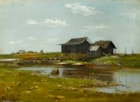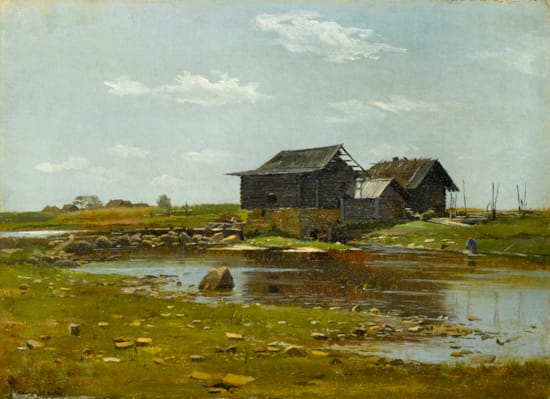udvig Ludvigovich Poplavsky
(Russian 1852 - 1885)
The Mill
signed in Cyrillic (lower left)
oil on canvas
28 x 39 cm (11 x 15¼ in)
Upon the empty fields there pours the azure glow
Of skies that have not lost the warmth of summer
-Feodor Ivanovich Tryutchev
The Mill by Ludvig Ludvigovich Poplavsky depicts a working mill apparently at the height of summer. The bare land holds the heat of summer, emphasised by the rocks left exposed by the reduced waters of the mill pond, which lies beneath a nearly loudless blue sky. A work of stark realism, Poplavsky’s work uses landscape to express a specifically Russian sense of nature: a vast landscape is implied beyond the picture frame, in which this cluster of buildings appears isolated under a wide sky. The sense of space established by the painting’s composition gives it a majestic quality, and the sharp chiaroscuro and colour contrasts add a dramatic and romantic tone. The work demonstrates the role of landscape in nineteenth-century Russian consciousness, a more fatalistic approach than that found in the west.
The Mill recalls the work of the contemporary Russian artist Alexei Kondratyevich Savrasov (1830-97), specifically his work Landscape with a Rainbow, in which human habitation is subjected to the elements of the landscape where it resides. Both Popalavsky and Savrasov worked in the Russian lyrical landscape style. During the course of the nineteenth century, landscape came to play a unique role in Russian folk consciousness, featuring heavily in the country’s literature, mythology and visual art. The rigours of its climate, the difficulties of transportation and the intense isolation of the long winter months, contributed to a specifically Russian sense of nature. At this time most Russians, including landowners, peasants and serfs lived on the land. Even aristocrats returned to their country estates for part of the year to reconnect with the land and its people. By the 1860s landscape came to be imbued with political, moral and social meanings. In art, these ideas were articulated in the work of the Peredvizhniki group, often called ‘The Wanderers’ or the ‘Itinerants’. They were a group of Russian Realist artists who in protest to academic restrictions formed an artists’ cooperative which, in 1870, evolved into the Society for Travelling Art Exhibitions. This would have, no doubt, have influenced Poplavsky who was a student of the Imperial Academy of Arts in the 1870s. The group founded a new artistic code that was based on social and political critique. They interpreted Nikolai Gavrilovich Chernyshevsky’s (1828-1889) ideas by putting emphasis on the subject matter of their works and, like their friends and contemporaries Feodor Mikhaylovich Dostoevsky (1821-1881), Leo Nikolayevich Tolstoy (1828-1910), and Ivan Sergeyevich Turgenev (1818-1883), justifyied their activities by attempting to make their art useful to society, in addition to rejecting the ‘art for art’s sake’ philosophy of concurrent academic tradition.
Unfortunately Poplavsky died in his early thirties, before he could realise his full potential as an artist. However, in his short career he acheived notable success, winning several awards for his landscape and genre scenes. Today his work can be found in several museum collections, including that of the prestigious Tretyakov Gallery.
Upon the empty fields there pours the azure glow
Of skies that have not lost the warmth of summer
-Feodor Ivanovich Tryutchev
The Mill by Ludvig Ludvigovich Poplavsky depicts a working mill apparently at the height of summer. The bare land holds the heat of summer, emphasised by the rocks left exposed by the reduced waters of the mill pond, which lies beneath a nearly loudless blue sky. A work of stark realism, Poplavsky’s work uses landscape to express a specifically Russian sense of nature: a vast landscape is implied beyond the picture frame, in which this cluster of buildings appears isolated under a wide sky. The sense of space established by the painting’s composition gives it a majestic quality, and the sharp chiaroscuro and colour contrasts add a dramatic and romantic tone. The work demonstrates the role of landscape in nineteenth-century Russian consciousness, a more fatalistic approach than that found in the west.
The Mill recalls the work of the contemporary Russian artist Alexei Kondratyevich Savrasov (1830-97), specifically his work Landscape with a Rainbow, in which human habitation is subjected to the elements of the landscape where it resides. Both Popalavsky and Savrasov worked in the Russian lyrical landscape style. During the course of the nineteenth century, landscape came to play a unique role in Russian folk consciousness, featuring heavily in the country’s literature, mythology and visual art. The rigours of its climate, the difficulties of transportation and the intense isolation of the long winter months, contributed to a specifically Russian sense of nature. At this time most Russians, including landowners, peasants and serfs lived on the land. Even aristocrats returned to their country estates for part of the year to reconnect with the land and its people. By the 1860s landscape came to be imbued with political, moral and social meanings. In art, these ideas were articulated in the work of the Peredvizhniki group, often called ‘The Wanderers’ or the ‘Itinerants’. They were a group of Russian Realist artists who in protest to academic restrictions formed an artists’ cooperative which, in 1870, evolved into the Society for Travelling Art Exhibitions. This would have, no doubt, have influenced Poplavsky who was a student of the Imperial Academy of Arts in the 1870s. The group founded a new artistic code that was based on social and political critique. They interpreted Nikolai Gavrilovich Chernyshevsky’s (1828-1889) ideas by putting emphasis on the subject matter of their works and, like their friends and contemporaries Feodor Mikhaylovich Dostoevsky (1821-1881), Leo Nikolayevich Tolstoy (1828-1910), and Ivan Sergeyevich Turgenev (1818-1883), justifyied their activities by attempting to make their art useful to society, in addition to rejecting the ‘art for art’s sake’ philosophy of concurrent academic tradition.
Unfortunately Poplavsky died in his early thirties, before he could realise his full potential as an artist. However, in his short career he acheived notable success, winning several awards for his landscape and genre scenes. Today his work can be found in several museum collections, including that of the prestigious Tretyakov Gallery.





 contact
contact contact
contact +44 20 7313 8040
+44 20 7313 8040









